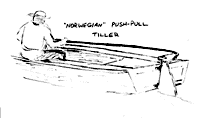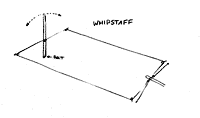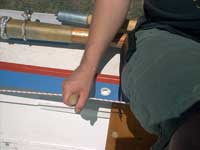| The first wheel steering system on
my Light Schooner was the sort typically seen –
a horizontal shaft system with a wooden wheel. I quickly
came to dislike this system on small sailboats. The
reactions are in the wrong direction. Sailors are
used to having a tiller pull against their hand. This
provides essential feedback on helm balance. If you
hold a such a wheel at the top, it pushes
against your hand. Backwards. I found I had to hold
the wheel near the bottom to have my reactions work
out right. But then you have to lean inboard and reach
awkwardly. Often just when you’d rather be hiking
out more! Very inconvenient in a lightweight boat.
I think the wheel would be fine in a big, heavy boat
where you can stand facing it no matter what the wind
is doing. But where you have to move your weight to
a gunwale, the typical wheel gets very inconvenient.
Unfortunately, my reasons for wanting remote steering
were still present – a big motor in a tiller’s
path, a wife wanting me in easy conversational range
(at the mainmast), and the need to keep my weight
out of the stern because of a heavy motor. So I started
looking at alternatives.
Long Tiller
While this is the simplest approach, it is prevented
by the motor being in the way. Even when sailing without
the motor, it is not necessarily desirable to have
such a long tiller. All tillers suffer from being
in the center of the boat. Why? To come about, you
have to put the helm down. But if you need to keep
your weight on the rail to keep the boat upright against
a strong wind, this is sometimes difficult or impossible.
And the longer the tiller, the bigger the problem.
The traditional solution is a hiking stick. I hate
hiking sticks. Either they are clumsy or I am.
Push-Pull “Norwegian” Tiller

While this system works perfectly well, it seems
highly counterintuitive to me. I haven’t actually
tried it, but I have trouble with the idea that it
pulls when it should push on one tack, but works the
right way around on the other tack. I bet it would
be intuitive when you’re looking at the lever
arm on the rudder post, but not so intuitive when
you’re not. I suppose it would work if you could
get used to the idea that push is starboard and pull
is port, but I don’t think in port and starboard
when sailing. I think in lee and weather. Maybe I’m
too stuck on the tiller, but to me “pull”
means turning downwind and “push” means
turning upwind.
It also seems that having to grip a rod while pushing
and pulling it would tire the hands. You could fix
this by adding a vertical handle to the rod, but this
doesn’t address the primary trouble.
An advantage, though, is that this sort of tiller
serves as its own hiking stick. You can steer from
anywhere the tiller can reach. It’s also relatively
easy to simply bend the tiller around obstacles, like
a motor. But on at least one tack it interferes with
cockpit space aft.
Reversed console tiller
OK, since we need to be sitting forward, suppose
we mount a remote tiller backwards on the forward
deck.
This one is tricky. The tip of the tiller would work
the same as a normal tiller. But the angle of the
tiller is opposite the angle of the rudder. That is,
you’d point the front of the tiller in the direction
you wanted to go. Rather like a single spoke of a
very large horizontal steering wheel. This doesn’t
seem all that intuitive. It also requires most of
the same gear as wheel steering and the same
clumsy hiking stick as any other tiller.
Whipstaff

The gear for a whipstaff is very simple. But for
hard sailing it would need the same clumsy hiking
stick as any other center-mounted tiller. And it also
needs to be rather tall to get enough leverage.
Regular Tiller Displaced Forward

If you can get past my crude sketch, you’ll
see that this is no more than an enhanced Norwegian
push-pull tiller. But the enhancement actually counts
for quite a lot, since it fixes the problems of insufficient
leverage, acting differently on each tack, and allows
the helmsman to wedge the steering without using any
hands. This is what Bolger used on the Birdwatcher,
and it actually works quite well.
Certainly this could work well on the schooner, bringing
the tiller post forward of the motorwell bulkhead.
It still wouldn’t be as close to my wife as
we’d like, but better than wedged against the
motorwell. Also, this lets the tiller drop down to
the floor so you can steer with your feet when standing
up in the slot top in light winds or when motoring.
A nice touch that I never would have thought of without
seeing it in person on Jim Michalak’s Birdwatcher.
You’d want some threaded adjustment couplings
like on an automotive steering tie rod. No reason
not to recycle some if you can weld. Or you could
use threaded rod and threaded couplers. I wouldn’t
use less than ½”. ¾” would
be better.
The benefit is that it is simpler and stronger than
cable over sheave steering. The difficulty is that
nothing can be in the way of the arc of the crank
arms or the push-pull shaft. This can be inconvenient
in an already-crowded motorwell. In my case, I could
have accommodated the lever arms, but the push-pull
shaft needed to go right through the only place I
could put the fuel tank. I didn’t feel like
rebuilding the motor well again. At least not so soon.
But this promising system may rise again. (Imagine
singlehanding from the forward cockpit!)
Side Mount Horizontal Tillers
Well, we could address that hiking stick problem
by putting a remote tiller on each side of the boat.
Catamaran folks know all about this. But this is at
the expense of complication. Each of those tillers
would need mechanism to use either push rods or cables
and sheaves. Because of the space that requires, I
think you’d only consider it on a boat with
side decks. It also means one more stick to foul the
sheets when coming about. In any case, all that complication
and expense seem like a poor trade to me. I think
I’d rather just brave getting used to the Norwegian
push-pull tiller.
Side Mount Vertical Tillers
So what if we use two separate whipstaffs –
one on each side of the boat? This is not an unknown
type of steering. It used be called a “monkey
stick”. Some of William Atkin’s designs
call for them. A few of Bolger’s too. Normally
these were used on powerboats that only needed one,
but a sailboat would require one on each side. But
that’s easy, since it takes hardly any gear
to make one.
Here the layout of your boat becomes important. You
should first decide whether you want the monkey sticks
forward or aft of the helmsman. This is important
because we want weather helm to pull against his hand.
He should always push to turn the boat downwind and
pull to bring it up. I favor the arrangement with
the monkey sticks behind the helmsman when sailing.
Then it also works intuitively when you’re sitting
centered under power. Like a bulldozer.
Assuming your rudder is controlled by a short tiller
in front of the rudderpost, the steering line has
to connect to the monkey sticks above the fulcrum
point. This is easiest to build, since the fulcrum
point can mount be on the boat’s bottom. It
also puts the longest possible scope of line under
the tiller’s control, which is good for control.
The monkey sticks seem perfect, but they’re
not. A vertical stick will tend to catch sheets when
tacking, especially off the wind. One might be able
to mitigate this by cutting off the sticks below the
rail and fitting a piece of pipe over them to steer.
But you’d have to take the pipe with you when
you tacked, and fit in on the other tiller in a hurry.
Better not drop it overboard! Perhaps one could have
one for each tiller, held to it with a lanyard.
Still, this seems fiddly. Sailing is fiddly enough.
Maybe we can simplify further.
Line steering with handles
If you’re going to run a line for vertical
tillers, do we need the levers? If that line can be
left exposed inside the cockpit, why not simply attach
a piece of dowel as a handle at the spot where you
would have put a lever? It is easy to attach with
a clove hitch.
In use, line steering is easy and intuitive. You
grab the handle and it acts just like a tiller, but
fore and aft. It works the same on both tacks. The
slight flex in the rope allows one to pull the handle
upward somewhat to a position comfortable for the
hand.

This one I tried out. In use the system was almost
everything I hoped it would be. It operated intuitively,
but it had an awful lot of resistance. In particular,
as I lifted upward on a handle, it would lock the
steering. On one hand, this function could be handy,
since it’s almost like jam-cleating the steering.
On the other hand, it was pretty stiff even in its
normal position. And this was after I replaced all
the fairleads with sheaves!
I guess it’s just too big a rudder to steer
this way. With 13 mph winds, sailing reefed it was
all I could to hold onto the handle at times. The
wind might have been up to 18 mph or so when it really
pulled, but no boat should become that hard to steer
in any wind.
That got me thinking more carefully about leverage.
A wheel can overcome all this with superior leverage.
This system has no leverage at all except the 2:1
tackle on the stub tiller. Maybe this shows us why
the monkey stick is helpful – adding leverage.
Sooo…..let’s try this monkey stick thing
after all.
Monkey Stick Steering Revisited
I wasn’t sure how well this would work, so
I didn’t want to spend a lot of effort working
up a permanent installation. So I tested the theory
by installing scrap wood sticks. For the bottom “hinge”
I bored a hole in one end of the stick and added a
screw eye in the chine. These were tied together with
a short piece of Dacron line. Above, I attached the
new stick to my old wooden handle with plastic wire
ties. Good enough to test it.
It worked so well I didn’t even bother showing
you pictures. A complete failure. To even double the
leverage, the stick would have to protrude at least
18” above the gunwale. This is simply unacceptable.
Imagine what a 15 foot long gaff boom would do to
that stick in a gybe. The old systems have the line
lower down, but we can’t do that because we
have to control 22” of cable to move the tiller
through its entire range. You can’t get 22”
of scope any closer to the axis of a stick system
than we already are. We could reduce that to 11”
if we eliminated the doubling sheaves on the tiller,
but then we’d be giving away as much mechanical
advantage as we got back.
So our leverage is stuck at 2:1 in this system. If
we shortened the tiller and used steel cable we might
be able to manage 4:1 at very best. But with the steering
wheel, the drum was 1.5” and the wheel is 18”,
yielding a ratio of 6:1 without taking up all that
space. And that doesn’t even count the doubling
sheaves, which make it 12:1! I began to see the beauty
of the wheel. But how to apply it to my situation?
As my arm was being pulled off in that 13 mph of
wind, I had my blinding flash of the obvious.
Vertical Shaft Wheel Steering
Mount the steering wheel horizontally, and it’s
easy and logical to grab the aft spokes of the wheel.
They pull on your hand just like a tiller. And the
spokes aren’t so long that you have to reach
for the lee rail when coming about. I would’ve
smacked my forehead, but letting go of the sheet would
have been a bad idea on that particular downwind run.

I’m thanking Billy Atkin and his descendants
for this one. I had been looking at his designs online
(www.atkinboatplans.com),
and noticing how some of his powerboats have a vertical
shaft steering wheel. Like Haven,
for example. This isn’t seen very often these
days, but it was relatively common in the 1940s.
I now think that this is the best wheel installation
for a small sailboat, if you’re fool enough
to demand a wheel at all. (Don’t!) Next time
we’ll look at how I installed the whole mess.
Rob Rohde-Szudy
Madison, Wisconsin, USA
robrohdeszudy@yahoo.com

Other Articles by Rob Rohde-Szudy:
|